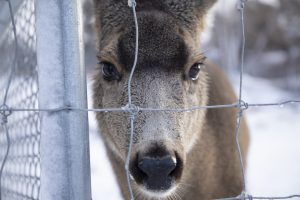Snickers
Sex: Female
Birthday: December 13, 2010
Snickers is a wild born female mule deer. She was brought to Zoo Idaho from Idaho Fish and Game because she was found as an orphan.
Sex: Female
Birthday: December 13, 2010
Snickers is a wild born female mule deer. She was brought to Zoo Idaho from Idaho Fish and Game because she was found as an orphan.
Sex: Female
Birthday: June 17, 2014
Sabrina came to Zoo Idaho as an orphan from Idaho Fish and Game.
Sex: Male
Birthday: April 24, 2014
Oliver was transferred to Zoo Idaho from Idaho Fish and Game after an officer confiscated the deer from a family in Nampa that was keeping it as a pet. Oliver can not be released because he is an imprinted deer.
Sex: Female
Birthday: June 8, 2015
Misty was transferred to Zoo Idaho from Idaho Fish and Game after it was rescued from a family in Niter, Idaho who claimed they rescued it after the mom abandoned the deer. Misty is a non-releasable mule deer.
Sex: Female
Birthday: May 27, 2016
Gigi was transferred to Zoo Idaho after she was rescued by Idaho Fish and Game as a small fawn.
Kingdom: Animalia
Phylum: Chordata
Class: Mammalia
Order: Artiodactyla
Family: Cervidae
Genus: Odocoileus
Species: Odocoileus hemionus

Not rare and apparently secure, but with cause for long-term concern
Mule deer occur over most of the North American west from southwest Saskatchewan through the western Great Plains and into parts of northern Mexico. They are remarkably adaptable occupying California woodland chaparral, the Mojave Sonoran desert, semi-desert shrub woodland, the Great Plains, the Colorado Plateau, the Great Basin, sagebrush steppe, and Canadian boreal forest.
Weight: Males, 99–330 lbs (45–150 kg); Females, 95–165 lbs (43–75 kg)
Length: Males, 4.3–5.6 ft (1.3–1.7 m); Females, 2.6–3.3 ft (0.8–1.0 m)
Shoulder height: Males, 2.75–3.6 ft (0.84–1.1 m); Females, 2.6–3.3 ft (0.8–1.0 m)
Mule deer range from brown to dark brown and dark and light ash gray. The rump patch is white to yellow and they have black tip on their white tail. They have a white throat patch with a dark v-shaped mark extending from a pint between the eyes upward laterally. Mule deer have large ears and along with the black tipped tail distinguishes them from the white-tailed deer.
Mule deer are intermediate feeders that predominantly browse but also eat fords, small amounts of grasses, and when available fruits, nuts, and berries.
Mule deer live up to 9-11 years in the wild and 20 or more years in captivity.
The mating period for mule deer begins in late fall and continues into February. The period is known as the rut where mature buck (male) mule deer compete for does (female). Gestation is approximately 200 days with one to four fawns (two average) born from late May to early June. Fawns are born with white spots that are utilized as camouflage. The spots fade within two to three months. Females reach sexual maturity around 18 months with males slightly earlier. Males however will not mate or be allowed to participate in rut until age three to four years.
Social structure is organized around family groups of related females and their offspring. Bucks between one to two years of age are removed from the family group. Adult bucks may form bachelor groups however most often they remain solitary. Mule deer will inhabit the same range throughout the year, however those found in northern and mountainous regions do migrate or move up and down elevation gradients. Mule deer are active throughout a 24-hour period with most activity occurring early morning and late afternoon/early evening.
Habitat fragmentation, disease, and hunting.